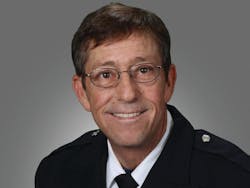Calif. Firefighter Dies After Suffering Heart Attack
Saunders, a 22-year veteran of the department, died Thursday morning at Mercy San Juan Medical Center. Fire officials said Saunders suffered a major heart attack on Saturday night while fighting the grass fire near Haggin Oaks Golf Course. He was 52 years old.
"He's one of the best," said Capt. Chris Greene, who worked with Saunders at Station 101 in the Arden Arcade area and who is also the family's spokesman. Greene described Saunders as a role model and a "phenomenal medical care provider."
According to a 2009 report by the National Fire Protection Association, sudden cardiac death remains the leading cause of on-duty firefighter fatalities, despite the declining numbers of firefighters dying from heart attacks in the line of duty since the late 1970s.
The study said that from 1977 through 1986, an average of 60 on-duty firefighters a year suffered sudden cardiac deaths. That average fell to 44 a year in the 1990s and to under 40 in the past decade. In 2009, 35 of 82 firefighters who died suffered a sudden cardiac event.
"It's a very stressful -- both physically and emotionally -- occupation," said David Finger, director of government relations with the National Volunteer Fire Council, which launched a program in 2003 to address heart attack prevention for firefighters.
When responding to an emergency, firefighters often "go from a resting heart rate of 60 to 80 beats per minute to almost double that," said Capt. Christian Pebbles, Sac Metro's spokesman.
"After years of that type of jolt to the heart, it's unnecessary wear and tear to the heart," Pebbles said.
Dr. Thomas Smith, a cardiologist with UC Davis Medical Center, said existing studies show that firefighters face an increased risk of fatal cardiovascular events during high-stress portions of their duties, but they do not show that firefighters are at a greater risk than the general population of dying from heart disease.
"While firefighters may enter the department in better cardiovascular shape than average individuals, they are not immune from developing hypertension and obesity," Smith said.
The particular stresses during an emergency call -- carrying heavy equipment and operating in a hot environment with a "fight or flight" response -- burden the heart with higher blood pressure and increased heart rate, Smith said. And he said this may be detrimental for those with undiagnosed coronary artery disease.
Sac Metro fire officials say they cannot divulge Saunders' medical history because of privacy issues, but Fire Chief Bill Sponable said Saunders spent a lifetime protecting his community and "gave the ultimate sacrifice."
Saunders, a Navy veteran, donated his liver, kidneys and other tissue for transplant, which will benefit three people, fire officials said.
Saunders always had a smile and loved to respond to, "How are you doing?" with a perky, "Just another day in paradise!" Greene said.
"He's looked to in the fire department as a role model for how to put out a fire," Greene said. "He is a friend to every person who calls 911. He speaks to them like they are a family member."
Saunders' survivors include his wife, Holly, and adult children Erik and Rachel. A "line-of-duty death" funeral is tentatively scheduled for Tuesday.
McClatchy-Tribune News Service
